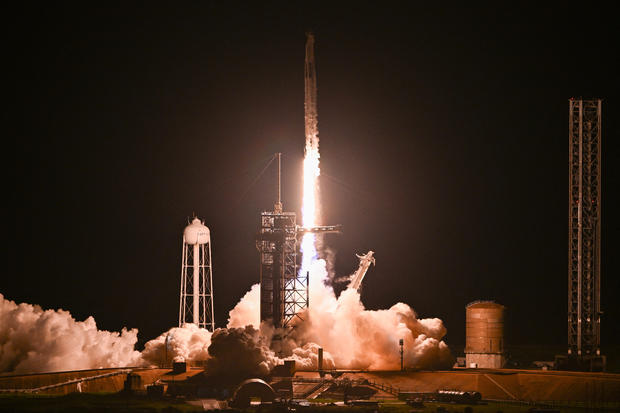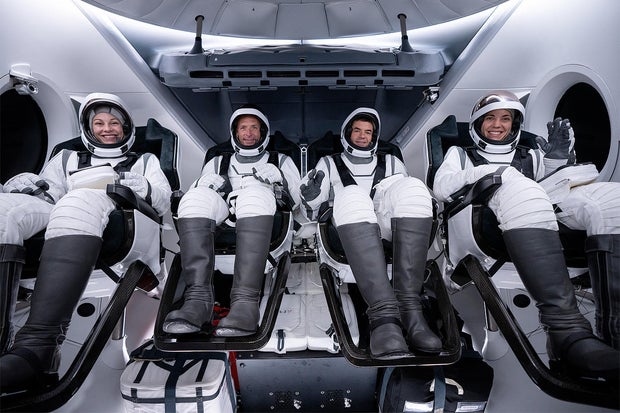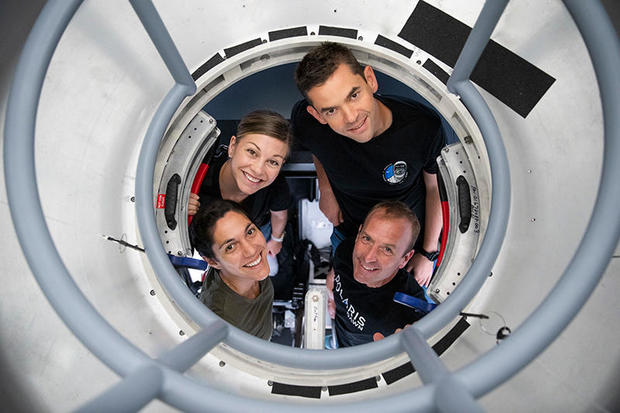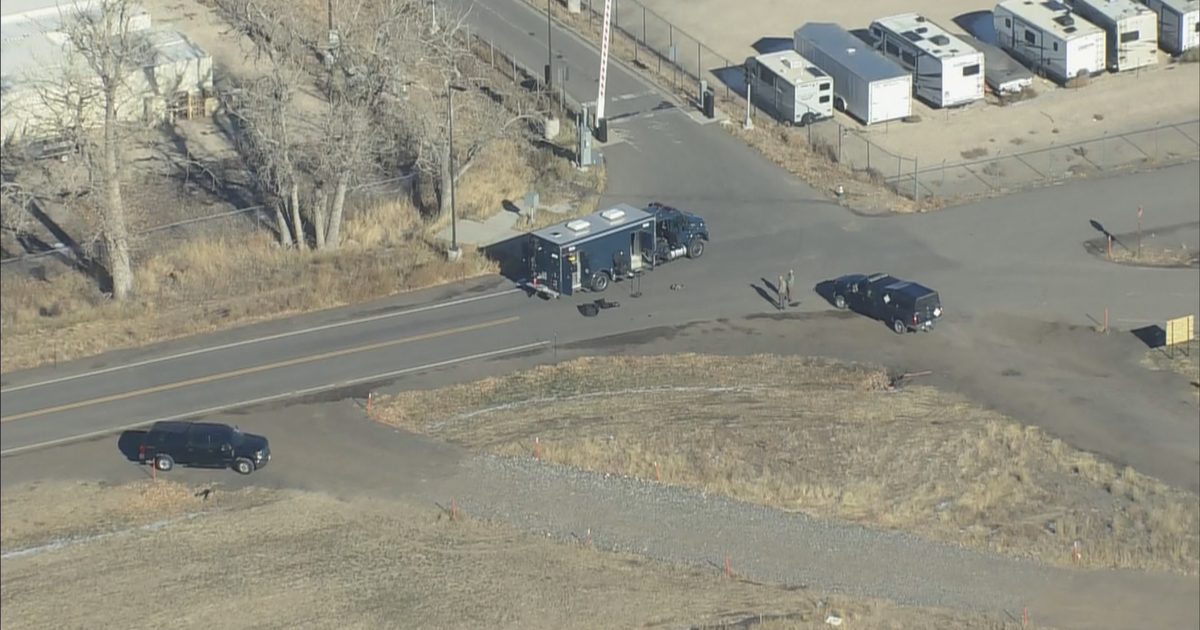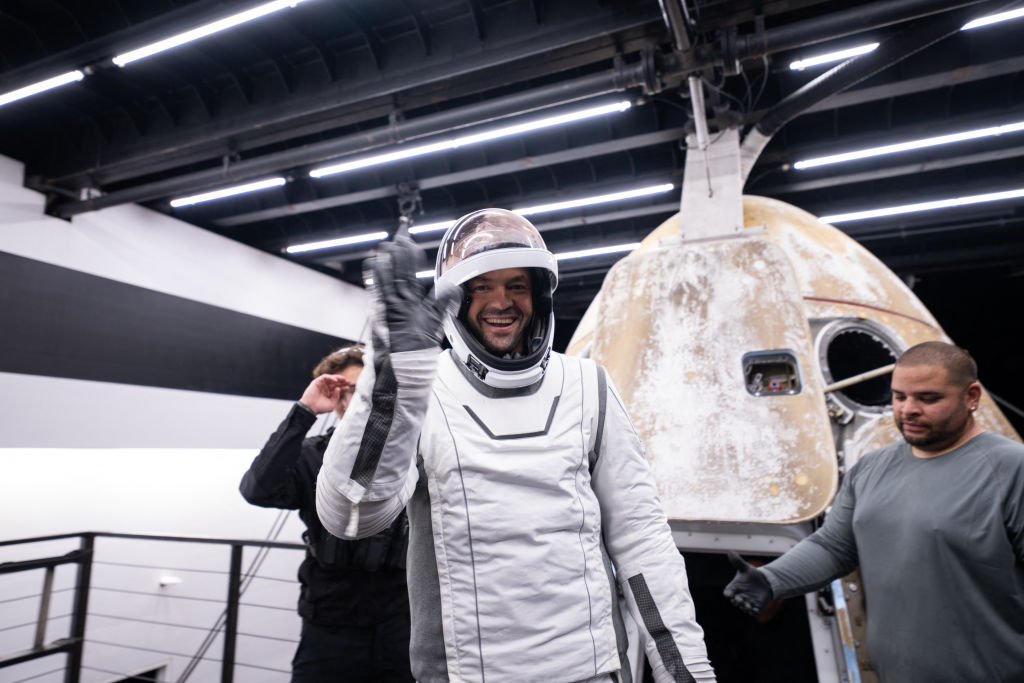SpaceX launches billionaire on Polaris Dawn mission slated to have first private spacewalk
A SpaceX Falcon 9 rocket vaulted into space early Tuesday, boosting billionaire Jared Isaacman and three crewmates into orbit for a daring attempt to set a post-Apollo astronaut altitude record and to carry out the first non-government spacewalk.
Wearing air-cooled SpaceX-designed suits and connected to their Crew Dragon spacecraft by umbilicals and safety tethers, Isaacman and SpaceX crew trainer Sarah Gillis plan to take turns spending about 15 minutes each just outside the ship's forward hatch early Thursday to put the suits to the test.
"My desire in human spaceflight is to move the needle," Isaacman, who chartered the first fully commercial Crew Dragon flight in 2021, said in an interview with CBS News. "It is not without risk, and you're taking that risk because you want to advance the ball forward, things that help SpaceX open up this frontier for everyone, for lots of people."
Running two weeks late, primarily due to predicted end-of-mission splashdown weather, SpaceX managers decided to press ahead for another launch try even though the on-shore forecast was 60 percent no-go.
As launch time approached, cloud buildups near the pad forced mission managers to delay launch to the second of three opportunities. This time around, the weather cooperated, and the first stage engines roared to life at 5:23 a.m. EDT, majestically pushing the slender rocket away from the Kennedy Space Center atop 1.7 million pounds of thrust.
Isaacman, Gillis and their two crewmates -- former F-16 pilot Scott Poteet and Anna Menon, a SpaceX mission director -- monitored the automated ascent on the Crew Dragon's futuristic touch-screen displays as they accelerated through low clouds toward space along the same northeasterly trajectory used by NASA space station crews.
Two-and-a-half minutes after liftoff, after boosting the second stage and Crew Dragon capsule out of the thick lower atmosphere, the first stage fell away and flew itself to a picture-perfect touchdown on an off-shore landing barge while the second stage continued the climb to orbit.
The second stage's single engine shut down nine minutes after liftoff and a few minutes after that, the Crew Dragon was released to fly on its own in an initial orbit with a high point, or apogee, of 745 miles and a low point, or perigee, of just 118 miles.
The International Space Station, in contrast, flies in a circular orbit at an altitude of about 260 miles.
"Today, you embark on a journey not just for yourselves, but for all humanity," Launch Director Frank Messina radioed from SpaceX mission control "We trust in your skills, your bravery and your teamwork to carry out the mission that lies ahead. ... Godspeed, Polaris Dawn crew. May you make history and come home safely."
Isaacman replied, "We appreciate the kind words. We wouldn't be on this journey without all 14,000 of you back at SpaceX and everyone else cheering us on. We appreciate it, and we're going to get to work now."
As the crew checked out the Crew Dragon's systems, flight controllers planned to start a carefully planned, 45-hour process to boost oxygen levels in the cabin while slowly decreasing air pressure to help remove nitrogen from the crew's bloodstreams.
The goal of the lengthy "pre-breathe" protocol is to prevent the bends, or decompression sickness, after the spacewalk on flight day three when all four transition down to 5 pounds per square inch pressure in their suits and then back up to the normal 14.6 psi cabin pressure.
Eight orbits into the mission, the Crew Dragon's thrusters were expected to boost the apogee up to 870 miles, a record altitude for a piloted Earth-orbit mission. Menon and Gillis will be farther from Earth than any of the 94 women launched into space before them. Only 27 Apollo astronauts, all men, have flown higher.
In any case, as the Crew Dragon passes through the high-altitude portion of each orbit, it will fly through a denser population of space debris than it will at the low point of the trajectory. By sticking to a highly elliptical orbit, the crew will lower the odds of an impact to a more acceptable level, roughly comparable to a lower-altitude circular orbit.
Another unusual factor: the crew will be exposed to higher radiation levels from the Van Allen belts, vast clouds of charged particles captured from the solar wind by Earth's magnetic field. The Van Allen belts start at an altitude of roughly 400 miles and extend out to 36,000 miles or so.
The Apollo astronauts passed through the Van Allen belts on the way to the moon and the Polaris Dawn crew will fly through their lower reaches. But researchers say Isaacman's crew will receive roughly the same radiation dosage during their five days in space as a space station crew gets during less than half of a normal six-month stay in orbit.
The Crew Dragon will only spend about 10 hours in that extremely elliptical orbit. After that, the ship's thrusters will fire again to lower the apogee to 435 miles. The ship will stay in that orbit for the spacewalk on flight day three and for the research the crew plans to carry out for the rest of the mission.
The spacewalk is perhaps the riskiest part of the mission other than launch and re-entry.
"Crew safety is absolutely paramount, and this mission carries more risk than usual, as it will be the furthest humans have traveled from Earth since Apollo and the first commercial spacewalk!" SpaceX founder Elon Musk tweeted before the initial launch try.
After venting the cabin to vacuum Wednesday evening, Isaacman and Gillis will take turns floating just outside the hatch early Thursday, using a ladder-like "Skywalker" scaffold for support. They'll spend about 15 minutes each testing the flexibility of their pressurized suits. They will remain connected to the Crew Dragon by 12-foot-long safety tethers and umbilicals.
From vacuum inside the Crew Dragon to cabin re-pressurization, the exercise is expected to take about two hours.
NASA astronaut Ed White carried out the first U.S. spacewalk on June 3, 1965, floating free of his Gemini 4 capsule at the end of a long tether. Isaacman said iconic photos of White floating against the backdrop of Earth and space were inspirational, but he and Gillis will not float free of the Crew Dragon. And that's by design.
"We're not going to be doing the Ed White float," Isaacman told CBS News. "That might look cool, but it doesn't really help SpaceX learn a lot about the performance (of the spacesuit). It's not very useful or helpful for figuring out how to be able to to work in a suit."
To that end, he and Gillis will work through a "matrix" of planned motions to get a feel for how the suit's multiple joints move while pressurized, to test the performance of an innovative heads-up display in the helmet, better understand how the air-cooled suits deal with the extreme temperatures of space and a variety of other factors.
The suit "includes all sorts of technology, including a heads-up display, a helmet camera, an entirely new architecture for joint mobility," Gillis said. "There's thermal insulation throughout the suit, including a copper and indium tin oxide visor that both provides thermal protection and solar protection."
In addition, she said, "there's all sorts of redundancy, both in the oxygen supply feed to the suit, as well as all of the valves, all of the seals across the suit. It's an incredible suit."
The spacewalk will be live streamed by SpaceX using cameras inside and outside the crew cabin that are expected to provide dramatic shots "to share with the world," she said.
While Isaacman and Gillis take turns floating just above the Crew Dragon's hatch, Poteet and Menon will monitor the tethers connected to their crewmates' suits, preventing any snags or tangles while keeping tabs on the Crew Dragon's systems, ready to assist if needed.
Once Gillis wraps up her turn and is back inside the Crew Dragon, the hatch will be closed and the cabin will be re-pressurized.
The day after the spacewalk, flight controllers plan to test a new laser link with SpaceX's constellation of Starlink internet satellites in low-Earth orbit to relay communications to and from Earth. The laser is mounted in the lower trunk section of the Crew Dragon.
"This is pretty cool," Isaacman said. "It is no small task to have two objects going 17,500 miles an hour,communicating over a beam of light. But it has the opportunity to open up an entirely new communication pathway, not just for Dragon but for armadas of Starships or other satellites or telescopes out there, and kind of free up some of the burden on the existing (satellite) and ground station infrastructure."
The rest of the Polaris Dawn mission will be devoted to completing the planned bio-medical research before setting up for re-entry and splashdown off the coast of Florida.
